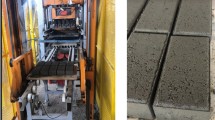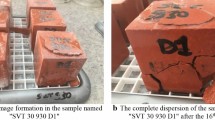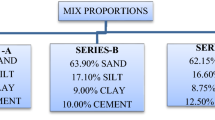Abstract
Construction technology in the twenty-first century is on the peak yet developing countries of the world still dream for shelter in bad weather conditions and apply old traditional techniques for construction of their houses. The reason is the increasing cost of construction materials due to energy crises, poor economic conditions, and sometimes the love of people toward earthen architecture culture. The world will prefer low energy alternatives to conventional construction. Some alternatives regarding conventional construction like mud block masonry are part of this research paper to avoid shrinking natural resources and take control of the energy crisis. This research work focuses on the compressive strength of the mud block by stabilizing it with additives like waste gypsum. The study also intended to investigate the rapid hardening of the masonry block. Finally, study the morphology of the stabilized blocks by using scanning electron microscopy and energy dispersive X-ray microanalysis (EDXMA). This research found that the compressive strength of waste gypsum-stabilized mud block at 7 days and 14 days increases with the increasing rate of waste gypsum from 0 to 20%. This research will help the poor community by reducing the economy and energy consumed in the construction of houses. Besides, this research will play a role by minimizing the consumption of natural resources, encourage people to reuse waste gypsum in construction without compromising on environmental pollution.







Similar content being viewed by others
References
Un.org. (2008). Habitat, U.N., The state of the world’s cities report. UN Habitat, Nairobi (2008).: https://www.un.org/ruleoflaw/files/Unhabitat_Report2634_alt.pdf
Dethier, J.: Des Architectures de Terre. Edition de Centre Pompidou, Paris. https://www.researchgate.net/publication/264119160_Study_of_a_new_interlocking_stabilised_compressed_earth_blocks. (1986)
Coffman, R.; Agnew, N.; Austin, G.; Doehne, E.: Adobe mineralogy: characterization of adobes from around the world. In: 6th International Conference on the Conservation of Earthen Architecture: Adobe 90 preprints: Las Cruces, New Mexico, 14–19 October, (1990)
Hadjri, K.; Boussaa, D.: Architectural and urban conservation in the United Arab Emirates. Open House Int. 32(3), 16–26 (2007)
Houben, H.; Guillaud, H.: Earth Construction: A Comprehensive Guide. ITDG Publishing, London (1994). ISBN-13: 978-1853391934
Schroeder, H.: Sustainable Building with Earth, p. 560. Springer, Switzerland (2016). https://doi.org/10.1007/978-3-319-19491-2
Rael, R.: Earth architecture. Princeton architectural press, Princeton (2009)
Minke, G.: Building with Earth, 3rd edn, p. 208. Birkhäuser, Basel (2012)
Cid-Falceto, J.; Mazarrón, F.R.; Cañas, I.: Assessment of compressed earth blocks made in Spain: international durability tests. Constr. Build. Mater. 37, 738–745 (2012)
Shah, A.; Khan, H.; Qazi, E.: Damage assessment of flood affected mud houses in Pakistan. J. Himal. Earth Sci. 46(1), 99–110 (2013)
Khan, A.N.: Analysis of 2010-flood causes, nature and magnitude in the Khyber Pakhtunkhwa, Pakistan. Nat. Hazards 66(2), 887–904 (2013)
Qasim, S.; Qasim, M.; Shrestha, R.P.; Khan, A.N.; Tun, K.; Ashraf, M.: Community resilience to flood hazards in Khyber Pukhthunkhwa province of Pakistan. Int. J. Disaster Risk Reduct. 18, 100–106 (2016)
Sabir, M.A.; Shafiq-Ur-Rehman, S.; Umar, M.; Waseem, A.; Farooq, M.; Khan, A.R.: The impact of suspended sediment load on reservoir siltation and energy production: a case study of the Indus River and its tributaries. Pol. J. Environ. Stud. 22(1), 219–225 (2013)
Reddy, B.V.; Mani, M.: (eds.), International Symposium on Earthen Structures, Interline Publishing, Bangalore, pp. 294–302 (2007)
Sharma, V.; Marwaha, B.M.; Vinayak, H.K.: Enhancing durability of adobe by natural reinforcement for propagating sustainable mud housing. Int. J. Sustain. Built Environ. 5(1), 141–155 (2016)
Vilane, B.R.T.: Assessment of stabilisation of adobes by confined compression tests. Biosyst. Eng. 106(4), 551–558 (2010)
Walker, P.J.: Strength and erosion characteristics of earth blocks and earth block masonry. J. Mater. Civ. Eng. 16(5), 497–506 (2004)
Porter, R.C.: The Economics of Waste. Routledge, Abingdon (2010)
Abbood D.W.: RecShow’08 Middle East Recycling, Waste & Environmental Management Exhibition & Congress Kempinski Hotel, Dead Sea-Jordan, 17–19 Feb 2008, (2008)
Abidoye, L.K.; Bello R.A.: Restoration of compressive strength of recycled gypsum board powder. Pac. J. Sci. Technol., Available: www.researchgate.net (2010).
Pinheiro, S.M.; Camarini, G.: Characteristics of gypsum recycling in different cycles. Int. J. Eng. Technol. 7(3), 215 (2015)
Magallanes-Rivera, R.X.; Juarez-Alvarado, C.A.; Valdez, P.; Mendoza-Rangel, J.M.: Modified gypsum compounds: an ecological–economical choice to improve traditional plasters. Constr. Build. Mater. 37, 591–596 (2012)
Ahmed, A.; Ugai, K.: Environmental effects on durability of soil stabilized with recycled gypsum. Cold Reg. Sci. Technol. 66(2–3), 84–92 (2011)
Chandara, C.; Azizli, K.A.M.; Ahmad, Z.A.; Sakai, E.: Use of waste gypsum to replace natural gypsum as set retarders in portland cement. Waste Manag. 29(5), 1675–1679 (2009)
Pakistan shelter guide, National disaster management Agency (NDMA) Pakistan. (2017). https://www.iom.int/sites/default/files/our_work/Shelter/documents/Shelter Construction-Guide
Wang, H.; Yang, L.; Li, H.; Zhou, X.; Wang, X.: Using coupled rheometer-FBRM to study rheological properties and microstructure of cemented Paste Backfill. Adv. Mater. Sci. Eng. 2019, 1–10 (2019)
Mat Nawi, A.: Effect of waste plaster of paris on physical and mechanical properties of ceramic pottery body. PhD Thesis., Universiti Tun Hussein Onn Malaysia, (2016)
Wong, H.H.; Kwan, A.K.: Packing density of cementitious materials: part 1—measurement using a wet packing method. Mater. Struct. 41(4), 689–701 (2008)
Wong, H.H.; Kwan, A.K.: Packing density of cementitious materials part 2—packing and flow of OPC + PFA + CSF. Mater. Struct. 41, 773 (2008). https://doi.org/10.1617/s11527-007-9281-6
Lai, M.; Hanzic, L.; Ho, J.C.: Fillers to improve passing ability of concrete. Struct. Concr. 20(1), 185–197 (2019)
Li, Z.; Zhang, J.; Li, S.; Gao, Y.; Liu, C.; Qi, Y.: Effect of different gypsums on the workability and mechanical properties of red mud-slag based grouting materials. J. Clean. Prod. 245, 118759 (2020)
Rogers, C.D.F.; Glendinning, S.; Roff, T.E.J: Lime modification of clay soils for construction expediency. In: Proceedings of the Institution of Civil Engineers-Geotechnical Engineering, vol. 125, No. 4 (1997)
ASTM, D-422 Standard test method for particle-size analysis of soils. Annual Book of ASTM Standards. (2007)
ASTM D 1557 Standard test method for laboratory compaction characteristics of soil” using modified effort (56,000 ft-lbf/ft3 (2,700 kN-m/m3)). Annual Book of ASTM Standards 04(08) (2007).
ASTM D 2487 Standard practice for classification of soils for engineering purposes (Unified Soil Classification System). Annual Book of ASTM Standards 04(08) (2007)
ASTM D 854-00 Standard test method for specific gravity of soil solids by water pycnometer. Annual book of ASTM Standards 04(08) (2002)
ASTM D 2434 Standard test method for permeability of soil solids by static head permeability method. Annual book of ASTM Standards 04(08) (2002)
BS 1377-3(1990): 1990. Methods of Test for Soils for Civil Engineering Purposes - Part 3: Chemical and Electro-Chemical Tests
Kinuthia, J.M.; Wild, S.; Jones, G.I.: Effects of monovalent and divalent metal sulphates on consistency and compaction of lime-stabilised kaolinite. Appl. Clay Sci. 14(1–3), 27–45 (1999)
Oti, J.E.; Kinuthia, J.M.; Bai, J.: Engineering properties of unfired clay masonry bricks. Eng. Geol. 107(3–4), 130–139 (2009)
Balkis, A.P.: The effects of waste marble dust and polypropylene fiber contents on mechanical properties of gypsum stabilized earthen. Constr. Build. Mater. 134, 556–562 (2017)
Author information
Authors and Affiliations
Corresponding author
Rights and permissions
About this article
Cite this article
Iqbal, K., Hussain, S. & Farooq, A. Influence of Waste Gypsum on the Microstructural Characteristics and Strength Behavior of Unfired Mud Block. Arab J Sci Eng 45, 8551–8560 (2020). https://doi.org/10.1007/s13369-020-04749-3
Received:
Accepted:
Published:
Issue Date:
DOI: https://doi.org/10.1007/s13369-020-04749-3




